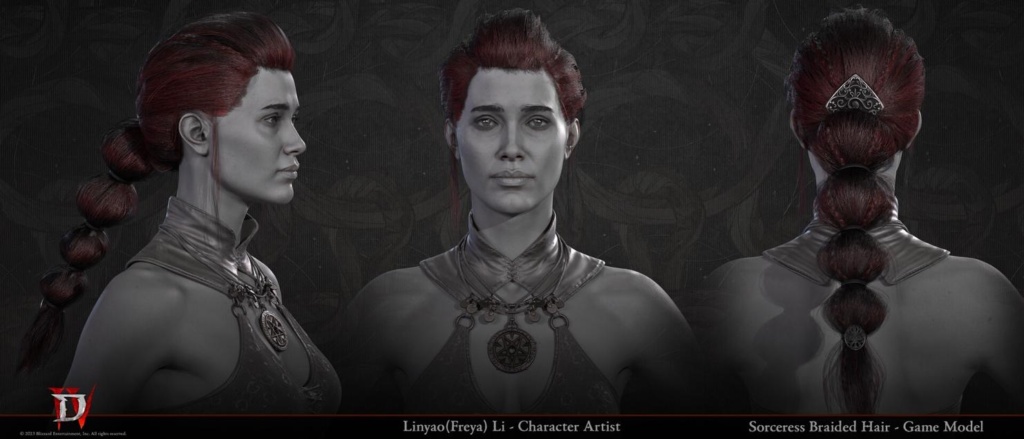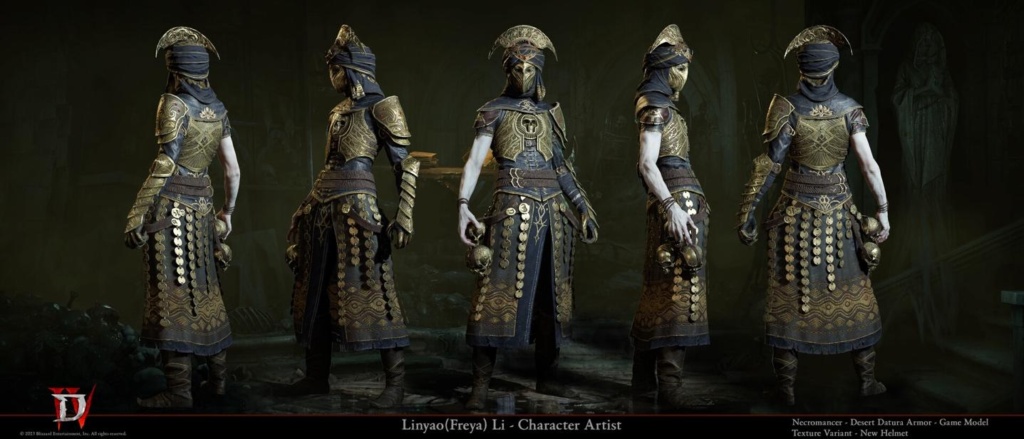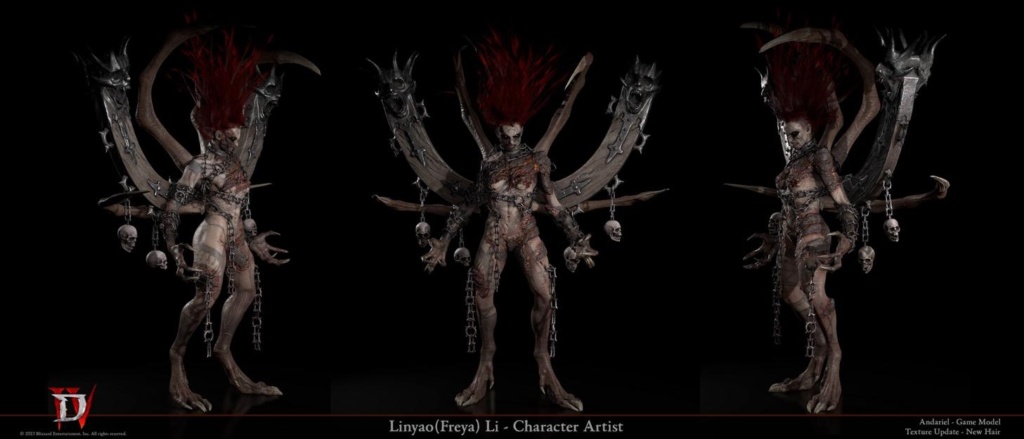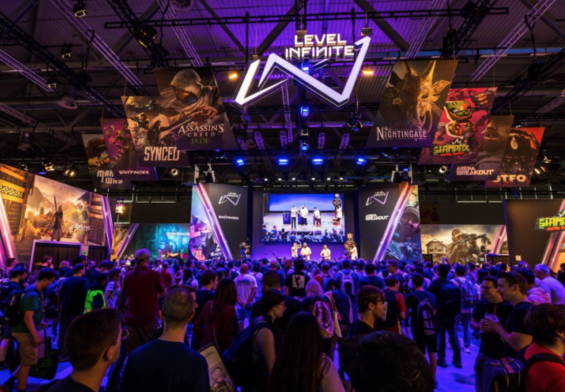
Prelude
Blizzard Games’ art style set many industry standards that define the fantastic fantasy charm of 2D and 3D art. They create many household characters that have prevailed among hard-core gamers for decades. Freya’s work with the Diablo team is focused on character design, such as armor, hairstyle, texture, and skins. As an artist still exploring her own art style and career path, it’s an invaluable experience for her to work with the best game artists in the world.
Self-Introduction, Personal background, and professional experience
My name is Linyao (Freya) Li, and I am currently a 3D Character Artist on the Diablo IV development team at Blizzard Entertainment. My journey in the world of 3D art began as a 3D Generalist at Petrol Advertising, where I had the opportunity to work on some of the biggest AAA game franchises. This role allowed me to gain extensive experience in the cinematic character creation pipeline. After my time at Petrol Advertising, I joined Sony PlayStation as a 3D Scan Artist, contributing to the game MLB The Show 22. This experience was pivotal as it opened the door to me for real-time game art. Following this, I dedicated myself to the field of 3D game art, accumulating several years of experience in this dynamic industry.
Getting Into Character Art
How did you get into the art space from an advertising background?
My background is a bit “complicated,” but in a fun way! From as long as I can remember, I was immersed in learning Chinese painting and calligraphy, which planted the seed in my heart to become an artist. However, due to the emphasis on academics, painting remained a passionate interest rather than a primary focus.
After entering college, I initially studied Chinese Language and Literature for the first two years at Fudan University. During this period, I devoted much of my spare time to filming, photography, and visual design. Recognizing the need to formally pursue my artistic inclinations, I transferred my major to Advertising. This change allowed me to explore courses related to art foundations, design, and filming, as my university did not have a dedicated Art department.
Next stop: Carnegie Mellon University. At the Entertainment Technology Center, I dove into entertainment design and 3D art. It was like discovering a new world, and I realized 3D art was my true passion. Then I decided to build my career as a 3D artist post-graduation.
Looking back, I am grateful for my diverse experiences. Each step along the way has been invaluable, shaping me into the artist I am today.
What movie or game characters inspired you most? What’s your favorite character and how does it resonate with you?

Many character designs in games and movies have inspired me, but one that left a deep impression is the geisha robot from “Ghost in the Shell” (2017). This character beautifully combines traditional Asian aesthetics with futuristic elements, creating a visual that resonates deeply with me. I am always moved by character designs that incorporate traditional cultural elements. This relates to my cultural background. The geisha robot is a fascinating blend of the old and the new. This duality is something I aim to incorporate into my own work.
Art Skills
What are the fundamentals to learn in 3D modeling? Construction, gesture, human anatomy? What was your learning process when you first began to create characters?
I think 3D modeling is like sculpting but in a digital way. As you mentioned, construction, gesture, human anatomy are necessary. Additionally, mastering 3D software tools is crucial since they are our hands and brushes in the digital space. Learning tools like Maya, ZBrush, and Substance is essential.
My learning process combined two sides. For example, I used ZBrush, a digital sculpting tool, to create a complete human muscle structure and skeleton model. This not only helped me learn ZBrush but also gave me a deeper understanding of human anatomy. My first character creation was driven by interest. I picked a character design I liked the most and dived into creating it, regardless of the difficulty. During the process, if I didn’t know how to do something, I would search online tutorials or ask my mentors at school. The process was very much like problem-solving. Each new challenge was an opportunity to learn and improve, making the entire experience both educational and rewarding.
Working with AAA games: Character specifications–Armor/Texture/Hair Design
What’s the character creation process? Are there any principles or standards when producing a new character or skin?
The character creation process typically starts with a 2D concept design. Once the concept is approved, the Character Artist begins working on the 3D model, starting with the blockout phase. This is followed by high-poly sculpting to add more details, retopology to create a manageable mesh, texturing, grooming (for hair and fur), testing, and finally, deployment in the game engine.
The goal is to produce high-quality 3D assets ready for the game. The process is very much a blend of creativity and technical precision, ensuring that each character not only looks amazing but also performs well in the game environment. There are several principles and standards we adhere to:
Achieving the 2D Concept is the primary goal of staying true to the original 2D concept as much as possible.
Readability: Since game characters are viewed from a distance by the game camera, their silhouettes and shapes must be clear and recognizable. This ensures that players can easily identify and distinguish characters during gameplay.
Optimization: Unlike cinematic characters, game characters need to be optimized for real-time rendering. This means carefully managing the poly count to ensure the game runs smoothly without compromising visual quality.
How do you work with producers, lead artists, narrative designers, concept artists and 2D artists?
Collaboration is at the heart of game development. Producers play a crucial role in managing the project timeline, resources, and communication between different departments. I work closely with producers to keep my tasks on track and within schedule. Lead Artists provide the artistic direction for the project. I collaborate with lead artists to refine my work, get feedback, and make sure my designs align with the game’s art style and quality requirements. Narrative Designers craft the story and character arcs within the game. Understanding their vision for a character’s background and personality helps inform my design choices. Regular discussions with narrative designers ensure that the characters’ visual aspects complement their roles and narratives in the game. Concept Artists are often the starting point for character designs. They create the initial 2D concepts that I use as a foundation for 3D modeling. Collaboration with concept artists involves reviewing their designs, discussing potential technical issues, and ensuring that the transition from 2D to 3D retains the essence of the original concept.
What design style or theme are you fascinated with? Which artist has the most influence on you personally? What art form do you draw inspiration from?


A diverse range of cultures has likely influenced me, and my experiences have exposed me to various forms of art since childhood, such as Chinese painting and calligraphy, visual arts, pop art, photography, and literature. Therefore, I am easily moved by various art forms. Many artists have influenced me, such as the CG artist Michael Black. I admire his narrative shots and the profound meaning in his grand narrative scenes with characters. He has a unique understanding of composition and is meticulous about details. His mastery of character expressiveness, color composition, environmental rendering, and emotional expression is impressive. Overall, he is a CG artist worth learning from.
General Tips and Advice
Tips on how to interview with AAA Art Team, what can be expected in the communication process as a junior artist?
I think a portfolio is the most important aspect and is the key to securing an interview as a 3D artist. Here are a few tips:
Strong Portfolio: Ensure your portfolio showcases your best work and aligns with the art style of the company you are applying to. Break down each step and showcase the process in your portfolio. Highlight your skills in modeling, texturing, and art foundations like your study of human anatomy.
Understanding the Art Style: Familiarize yourself with the company’s art style. Demonstrating that you can create work in a similar style will make a strong impression.
Soft Skills: Art teams also look for strong communication, collaboration, and time management skills. Be prepared to discuss how you work in a team, handle feedback, and manage your time.
Show Passion: Genuine enthusiasm for the company’s projects can set you apart. Show that you are passionate about their work and how you can contribute to it.
During the interview, expect questions about your portfolio, your creative process, and your experiences working with a team. Be ready to discuss specific pieces of your work, the techniques you used, and how you approached challenges.
What advice would you give to early-career artists or newly-graduates with an art degree?
Keep learning, show off your work, ask for feedback, make friends, and don’t give up—oh, and stay passionate, even when your coffee runs out!
Some images from my portfolio: https://freyafreya.artstation.com/




This is an original interview conducted by ArtiZen with the artist. If you are a media and interested in reposting this article, please get in touch with our editorial team for reposting policy. artizen@minisoulart.com





1 Comment
Gigi Geng
A talented pretty girl LOL.
Comments are closed.